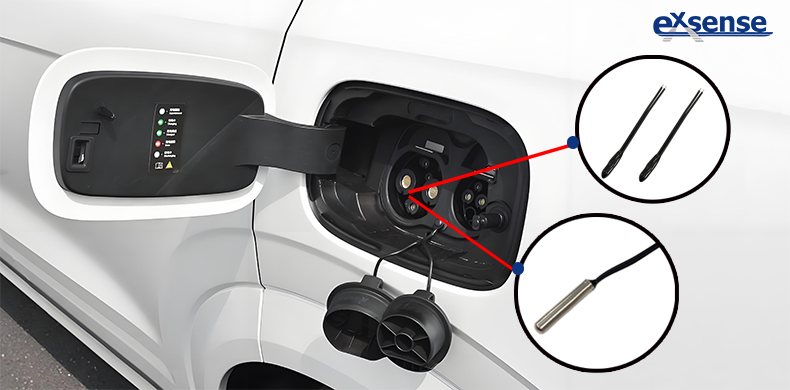New Energy Vehicle Charging Ports (“charging ports”) are core interface devices connecting charging piles and vehicles. They serve dual functions of electrical energy transmission and data communication. Installed on the exterior of vehicle bodies, charging ports generate heat at their internal electrical terminals during prolonged high-power charging. NTC temperature sensors enable real-time monitoring of terminal temperatures to prevent equipment damage caused by overheating.
Core Components of Charging Ports typically include:
- Electrical Terminal Assembly: Composed of high-conductivity copper alloy connectors and elastic contact plates, designed to meet the differentiated requirements of DC fast charging (200A/1000V)and AC slow charging (32A-63A/250V).
- Insulated Housing Assembly: Constructed from flame-retardant PC/ABS composite materials with an IP67 protection rating.
- Temperature Monitoring Module: Integrates NTC temperature sensorsand thermally conductive silicone pads for heat management.
- Communication Interface: Complies with the GB/T 27930 standardCAN bus communication protocol.
Electrical terminals generally consist of connectors and contact plates. Temperature-sensing NTCs are adjacent to both DC fast-charging and AC slow-charging socket units.
NTC Temperature Sensors (Negative Temperature Coefficient) are resistive sensors whose resistance decreases as temperature rises, making their temperature coefficient negative. This property makes them ideal for temperature monitoring in charging ports.
How NTC Sensors Enhance Charging Port Safety:
- Real-Time Temperature Monitoring:Thermal conductive components transfer heat from electrical terminals to the NTC sensor, enabling rapid temperature detection.The control system sets a safe operating range (-20°C to 50°C). If temperatures exceed 50°C, the charging current is automatically reduced to prevent equipment damage.
- Over-Temperature Protection:If terminal temperatures surpass the safety threshold (60°C) and continue rising, the charging management system immediately halts charging. This prevents overheating-induced port damage, battery overcharging, and critical failures like vehicle fires.
- Early Fault Detection:Continuous temperature monitoring identifies abnormal heat generation caused by poor contact or short circuits. Early warnings allow timely maintenance, averting safety risks before escalation.
Conclusion:
NTC temperature sensors ensure safe and efficient charging while optimizing equipment performance and longevity through precise thermal control. As technology advances, NTC sensors will remain pivotal in enhancing reliability and user experience in automotive charging systems.

